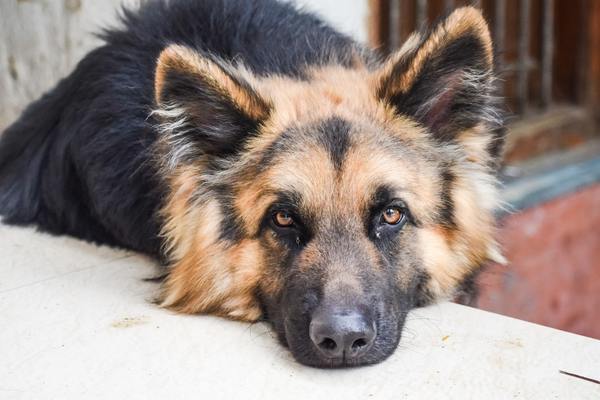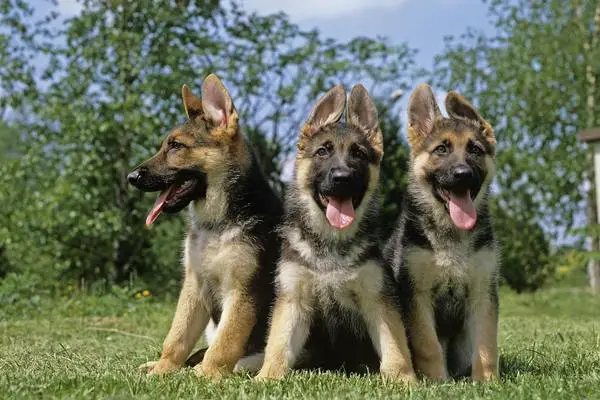You have probably seen this breed in movies, on TV, or maybe a friend in your neighborhood has one. German shepherds have some unique characteristics and traits that make them amazing dogs. From their powerful stature to their intelligence and loyalty, German Shepherds have been a popular breed for many decades. In this post, we’ll explore some characteristics of German shepherds, from their physical traits to their temperament and trainability.
12 Characteristics of German Shepherds
Known as “Alsatians” in Britain and some parts of Europe, the German Shepherd is one of the most recognizable dog breeds in the world. So, whether you’re a fan of the German Shepherd breed or just curious about what makes them so special, read on for an in-depth look at these remarkable animals.
Physical Traits
1. Head, Face and Muzzle

Among the most recognizable features of the German Shepherd breed are its facial features. The head is broad with a slightly domed forehead.
The eyes are almond-shaped and dark brown in color. Its pointy ears are erect and stand upright, giving it an alert expression.
The muzzle is long and tapered, with a black nose that blends into the top line of its face. Its teeth meet in a scissor bite, and its jaw has tremendous strength for gripping prey or carrying objects for long distances without tiring out quickly.
All these features give this breed an unmistakable look that sets it apart from other dogs making it easily identifiable.
2. Body Shape
The German Shepherd Dog is a powerfully built and muscular breed that has an elegant and highly agile body shape. The large, broad head gives the breed its characteristic look, while the muzzle tapers down to a strong chin.
The neck of the German Shepherd Dog is relatively long and slopes gracefully into strong, well-defined withers and a deep chest. They have a slightly curved back, with strong loins and a moderately long yet powerful croup. The legs are straight and sturdy, with an obvious angulation in the hindquarters that gives the breed remarkable agility.
3. Coat and Colors

One of the unique things about German Shepherd Dogs is that they don’t all have the same coat type. They also come in different colors and patterns that make them quite distinct. Their coats range from short, medium to long-haired and can be either a single or double coat.
Short-coated German Shepherds have a thick, protective topcoat of short, straight fur that adheres closely to their muscular frame. Their neck area has slightly longer and thicker hair compared to the other parts of their body, while the hind legs are accented with marginally longer fur from the hock down. In addition, they have longer fur on the rear of their forelegs.
Medium-haired German Shepherds, also known as plush coats, boast a unique look that blends the best qualities of both short-haired and long-haired breeds. With their extra fur length across the topcoat, these dogs have a full and fluffier appearance. This provides them with an aesthetic quality that many people find attractive.
The beautiful, long-coated German Shepherd has a silky, soft topcoat that falls away from the body. Its fur has a glossy sheen, often forming an even parting along the back. The ears and legs are adorned with feathery fur, while the neck area is thicker and longer in comparison – giving it an almost lion-like mane appearance.
The colors of a German Shepherd’s coat can range from sable, black and tan, black and cream, all the way to bi-colored or solid white. Most common colors include sable, which is a mottled blend of browns, yellows and grays; black and tan, which is usually made up of black with mahogany patches; and finally, the all-black variety. All German Shepherds have striking dark eyes and black noses, helping make them one of the most recognizable dog breeds in the world.
4. Height and Weight
It’s not unusual for people not to be able to differentiate between male and female German Shepherds just by looking at them, as they are both strong and muscular dogs that typically look similar. However, it’s important to note that their average weight and height can vary greatly between genders, with males being larger.
As puppies, males may weigh between 49-57 lbs and females 44-49 lbs at 6 months of age. By 3 years, the weight range increases to 79-88 lbs for males and 66-70 lbs for females. The height of male German Shepherds is usually 25 inches, while females are slightly smaller, standing at 23 inches at the withers.
5. Tail

The tail of a German Shepherd is one of its most distinguishing features. It is long and hangs low, with a slight upward curve at the end, but should never be curled over the back like some breeds. On average, it will measure between 9-14 inches in length, depending on the dog’s overall height and frame.
Long-coated Shepherds will have a fluffy plume, while short-coated dogs have sleeker tails. At full maturity, which usually occurs by 18 to 36 months old, you can better judge what type of tail your German Shepherd has.
This tail is not only a major part of their physical appearance, but it can also indicate the dog’s emotional state. If it is curled under the body instead of being held naturally straight out, the dog may be anxious or nervous. Taking care to understand and recognize your German Shepherd’s tail will help you build a better bond with them.
Behavior
6. Temperament
German Shepherds are highly intelligent and loyal dogs that thrive on mental stimulation. They are eager to please, making them easy to train, and they are excellent at tasks like herding and protection.
However, it’s important to remember that these working dogs need both physical and psychological stimulation to be happy and healthy. As such, regular exercise and plenty of positive reinforcement are essential when training.
Without proper socialization from a young age, a German Shepherd may become over-protective or shy around strangers – but with the right guidance, this behavior can easily be avoided. Despite their intimidating size, German Shepherds make wonderful family pets that are devoted to their owners.
7. Trainability

The American Kennel Club ranks the German Shepherd as one of the most trainable breeds, and they are often used in service and search-and-rescue roles. They learn quickly and respond well to positive reinforcement–so it’s important to be patient and consistent when training your GSD.
It’s best to start early so that all basic obedience commands can be mastered, like “sit,” “stay,” and “come.” German Shepherds have a strong prey drive, so you will also need to work on teaching them not to pull on their leash. With patience and consistency, your German Shepherd will soon become an obedient dog that is a joy to have around.
8. Barking
German Shepherds are not known to be excessive barkers. However, they will use their deep bark to alert you of potential threats or when playing with other dogs.
If your GSD barks too much at home, it could mean they are bored or not getting enough exercise. Ensure your dog is given plenty of playtime and mental stimulation to properly tire them out before bedtime.
Health
9. Common Issues

As with any breed, German Shepherds are prone to certain health issues. This includes hip and elbow dysplasia, a genetic disorder that can cause lameness or arthritis. Other common health problems include eye diseases such as progressive retinal atrophy (PRA), an inherited condition affecting the retina that can lead to blindness in some cases.
It’s important to note that many of these conditions can be prevented or reduced by having your GSD regularly checked by a vet and ensuring they get proper nutrition and exercise throughout their life. With that said, most German Shepherds live long and healthy lives with proper care.
10. Life Expectancy
The average life expectancy for a German Shepherd is between 10-13 years if they are properly cared for and live a healthy lifestyle. This can vary slightly depending on the size and gender of the dog, as well as any hereditary conditions that may need to be monitored over the course of their lifetime.
11. Grooming
Due to their double coat, German Shepherds will require regular brushing and grooming to keep their fur healthy and looking its best. They should be brushed at least once a week using a long-toothed comb or slicker brush and will also need occasional baths.
Additionally, German Shepherds are prone to ear infections, so it’s important to clean their ears regularly with an ear-cleaning solution that is specifically formulated for dogs’ ears. This will help prevent any potential build-up of wax or debris that could lead to infection.
12. Litter Size

A litter typically consists of six to eight puppies, although larger litters are not uncommon. The gestation period for German Shepherds is typically 63 days, with the puppies weighing about 1.1 pounds at birth. They are usually born with their eyes closed but will begin opening them after 7 to 10 days.

